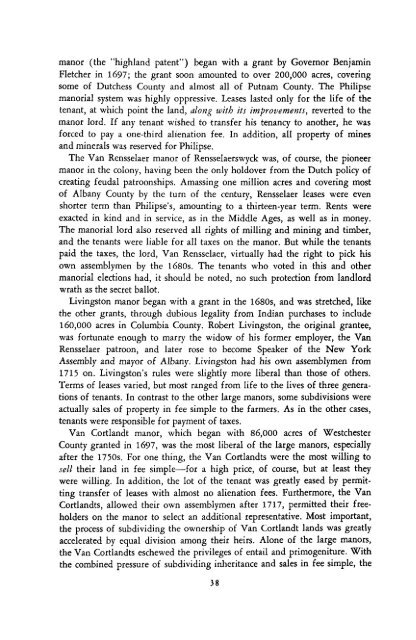Conceived in Liberty Volume 2 - Ludwig von Mises Institute
Conceived in Liberty Volume 2 - Ludwig von Mises Institute
Conceived in Liberty Volume 2 - Ludwig von Mises Institute
Create successful ePaper yourself
Turn your PDF publications into a flip-book with our unique Google optimized e-Paper software.
manor (the "highland patent") began with a grant by Governor Benjam<strong>in</strong><br />
Fletcher <strong>in</strong> 1697; the grant soon amounted to over 200,000 acres, cover<strong>in</strong>g<br />
some of Dutchess County and almost all of Putnam County. The Philipse<br />
manorial system was highly oppressive. Leases lasted only for the life of the<br />
tenant, at which po<strong>in</strong>t the land, along with its improvements, reverted to the<br />
manor lord. If any tenant wished to transfer his tenancy to another, he was<br />
forced to pay a one-third alienation fee. In addition, all property of m<strong>in</strong>es<br />
and m<strong>in</strong>erals was reserved for Philipse.<br />
The Van Rensselaer manor of Rensselaerswyck was, of course, the pioneer<br />
manor <strong>in</strong> the colony, hav<strong>in</strong>g been the only holdover from the Dutch policy of<br />
creat<strong>in</strong>g feudal patroonships. Amass<strong>in</strong>g one million acres and cover<strong>in</strong>g most<br />
of Albany County by the turn of the century, Rensselaer leases were even<br />
shorter term than Philipse's, amount<strong>in</strong>g to a thirteen-year term. Rents were<br />
exacted <strong>in</strong> k<strong>in</strong>d and <strong>in</strong> service, as <strong>in</strong> the Middle Ages, as well as <strong>in</strong> money.<br />
The manorial lord also reserved all rights of mill<strong>in</strong>g and m<strong>in</strong><strong>in</strong>g and timber,<br />
and the tenants were liable for all taxes on the manor. But while the tenants<br />
paid the taxes, the lord, Van Rensselaer, virtually had the right to pick his<br />
own assemblymen by the 1680s. The tenants who voted <strong>in</strong> this and other<br />
manorial elections had, it should be noted, no such protection from landlord<br />
wrath as the secret ballot.<br />
Liv<strong>in</strong>gston manor began with a grant <strong>in</strong> the 1680s, and was stretched, like<br />
the other grants, through dubious legality from Indian purchases to <strong>in</strong>clude<br />
160,000 acres <strong>in</strong> Columbia County. Robert Liv<strong>in</strong>gston, the orig<strong>in</strong>al grantee,<br />
was fortunate enough to marry the widow of his former employer, the Van<br />
Rensselaer patroon, and later rose to become Speaker of the New York<br />
Assembly and mayor of Albany. Liv<strong>in</strong>gston had his own assemblymen from<br />
1715 on. Liv<strong>in</strong>gston's rules were slightly more liberal than those of others.<br />
Terms of leases varied, but most ranged from life to the lives of three generations<br />
of tenants. In contrast to the other large manors, some subdivisions were<br />
actually sales of property <strong>in</strong> fee simple to the farmers. As <strong>in</strong> the other cases,<br />
tenants were responsible for payment of taxes.<br />
Van Cortlandt manor, which began with 86,000 acres of Westchester<br />
County granted <strong>in</strong> 1697, was the most liberal of the large manors, especially<br />
after the 1750s. For one th<strong>in</strong>g, the Van Cortlandts were the most will<strong>in</strong>g to<br />
sell their land <strong>in</strong> fee simple—for a high price, of course, but at least they<br />
were will<strong>in</strong>g. In addition, the lot of the tenant was greatly eased by permitt<strong>in</strong>g<br />
transfer of leases with almost no alienation fees. Furthermore, the Van<br />
Cortlandts, allowed their own assemblymen after 1717, permitted their freeholders<br />
on the manor to select an additional representative. Most important,<br />
the process of subdivid<strong>in</strong>g the ownership of Van Cortlandt lands was greatly<br />
accelerated by equal division among their heirs. Alone of the large manors,<br />
the Van Cortlandts eschewed the privileges of entail and primogeniture. With<br />
the comb<strong>in</strong>ed pressure of subdivid<strong>in</strong>g <strong>in</strong>heritance and sales <strong>in</strong> fee simple, the<br />
38
















